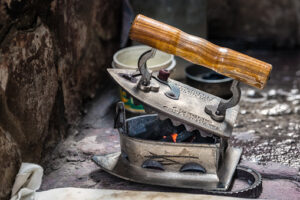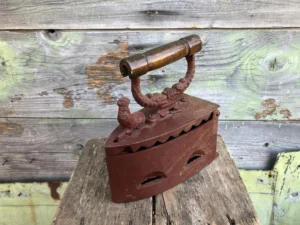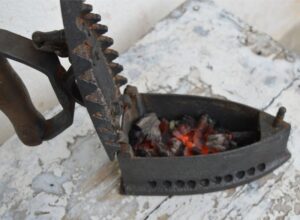In the realm of household tools, some inventions have quietly persevered through centuries, leaving a remarkable trace in the sands of time. Today, let’s embark on a journey back in history, where the pursuit of sartorial perfection met the ingenious craftsmanship of the charcoal iron.
Picture this – a quaint village in ancient Asia, where an elegant solution was brewing to tackle wrinkled linen shirts and silk dresses. Charcoal irons, as the name suggests, harnessed the power of burning charcoal to create the perfect press, making them a captivating chapter in the evolution of domestic appliances.

The origins of these remarkable irons can be traced back to the 8th century BC, with a mention in Homer’s epic, the Odyssey. However, it wasn’t until the 17th century AD that these ironing marvels began to take tangible form, finding their place in households. China and India, in particular, played a pivotal role in their development, crafting them from robust cast iron or elegant brass.
These charcoal irons bore an unmistakable oval or rectangular shape, boasting a hinged top that concealed a charcoal chamber. Ventilation holes ensured a steady burn, maintaining the iron’s heat at optimal levels. The handle, often fashioned from wood or insulated with cork, shielded the user from the radiating warmth, transforming ironing into an art form.

What set charcoal irons apart was their relentless supply of high heat, a quality that made them indispensable for ironing heavier fabrics. Yet, the process required patience and precision, as a careless touch could result in soot-stained attire.
As the 19th and early 20th centuries unfolded, charcoal irons conquered continents, gracing the homes of Europe, Asia, and Africa. In rural America, where electricity was still a distant dream, charcoal irons reigned supreme. But by the mid-20th century, the electrification wave rendered them obsolete, consigning them to the annals of history.

But wait, the story doesn’t end there. In pockets of Asia and Africa, where electricity remains sporadic or costly, these relics of a bygone era find purpose to this day. They are lovingly collected and displayed by antique enthusiasts, sometimes even taking center stage as props in historical dramas and films. Their legacy lives on as they continue to inspire the design of gas irons and have left an indelible mark on the evolution of self-heating electric irons.
The history of charcoal irons is a testament to human ingenuity and the unending pursuit of aesthetic perfection. It’s a tale of adaptation, survival, and profound influence. From ancient Asian homes to the hallowed halls of 21st-century antique collections, they’ve embarked on an incredible journey, etching their legacy into the history of household conveniences. As modern technology forges ahead, the charcoal iron serves as a wistful reminder of our humble beginnings in the world of domestic craftsmanship.